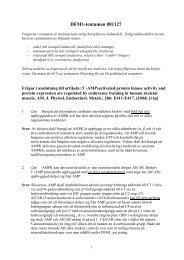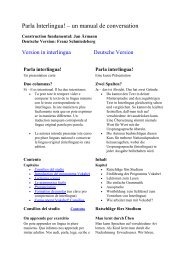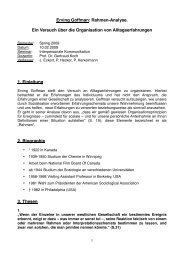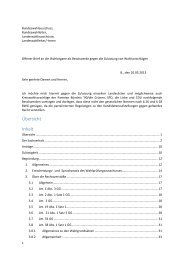lwIP - A Minimal TCP/IP implementation - Wikia
lwIP - A Minimal TCP/IP implementation - Wikia
lwIP - A Minimal TCP/IP implementation - Wikia
You also want an ePaper? Increase the reach of your titles
YUMPU automatically turns print PDFs into web optimized ePapers that Google loves.
4 PROCESS MODEL<br />
more efficiently reuse buffers. Also, since the application process can use the same memory as the<br />
networking code the application can read and write directly to the internal buffers, thus saving<br />
the expense of performing a copy.<br />
3 Overview<br />
As in many other <strong>TCP</strong>/<strong>IP</strong> <strong>implementation</strong>s, the layered protocol design has served as a guide<br />
for the design of the <strong>implementation</strong> of <strong>lw<strong>IP</strong></strong>. Each protocol is implemented as its own module,<br />
with a few functions acting as entry points into each protocol. Even though the protocols are<br />
implemented separately, some layer violations are made, as discussed above, in order to improve<br />
performance both in terms of processing speed and memory usage. For example, when verifying<br />
the checksum of an incoming <strong>TCP</strong> segment and when demultiplexing a segment, the source and<br />
destination <strong>IP</strong> addresses of the segment has to be known by the <strong>TCP</strong> module. Instead of passing<br />
these addresses to <strong>TCP</strong> by the means of a function call, the <strong>TCP</strong> module is aware of the structure<br />
of the <strong>IP</strong> header, and can therefore extract this information by itself.<br />
<strong>lw<strong>IP</strong></strong> consists of several modules. Apart from the modules implementing the <strong>TCP</strong>/<strong>IP</strong> protocols<br />
(<strong>IP</strong>, ICMP, UDP, and <strong>TCP</strong>) a number of support modules are implemented. The support modules<br />
consists of the operating system emulation layer (described in Section 5), the buffer and memory<br />
management subsystems (described in Section 6), network interface functions (described in Section<br />
7), and functions for computing the Internet checksum. <strong>lw<strong>IP</strong></strong> also includes an abstract API, which<br />
is described in Section 12.<br />
4 Process model<br />
The process model of a protocol <strong>implementation</strong> describes in which way the system has been divided<br />
into different processes. One process model that has been used to implement communication<br />
protocols is to let each protocol run as a stand alone process. With this model, a strict protocol<br />
layering is enforced, and the communication points between the protocols must be strictly defined.<br />
While this approach has its advantages such as protocols can be added at runtime, understanding<br />
the code and debugging is generally easier, there are also disadvantages. The strict layering is<br />
not, as described earlier, always the best way to implement protocols. Also, and more important,<br />
for each layer crossed, a context switch must be made. For an incoming <strong>TCP</strong> segment this would<br />
mean three context switches, from the device driver for the network interface, to the <strong>IP</strong> process,<br />
to the <strong>TCP</strong> process and finally to the application process. In most operating systems a context<br />
switch is fairly expensive.<br />
Another common approach is to let the communication protocols reside in the kernel of the<br />
operating system. In the case of a kernel <strong>implementation</strong> of the communication protocols, the<br />
application processes communicate with the protocols through system calls. The communication<br />
protocols are not strictly divided from each other but may use the techniques of crossing the<br />
protocol layering.<br />
<strong>lw<strong>IP</strong></strong> uses a process model in which all protocols reside in a single process and are thus separated<br />
from the operating system kernel. Application programs may either reside in the <strong>lw<strong>IP</strong></strong><br />
process, or be in separate processes. Communication between the <strong>TCP</strong>/<strong>IP</strong> stack and the application<br />
programs are done either by function calls for the case where the application program shares<br />
a process with <strong>lw<strong>IP</strong></strong>, or by the means of a more abstract API.<br />
Having <strong>lw<strong>IP</strong></strong> implemented as a user space process rather than in the operating system kernel<br />
has both its advantages and disadvantages. The main advantage of having <strong>lw<strong>IP</strong></strong> as a process is that<br />
is portable across different operating systems. Since <strong>lw<strong>IP</strong></strong> is designed to run in small operating<br />
systems that generally do not support neither swapping out processes not virtual memory, the<br />
delay caused by having to wait for disk activity if part of the <strong>lw<strong>IP</strong></strong> process is swapped or paged<br />
out to disk will not be a problem. The problem of having to wait for a scheduling quantum before<br />
getting a chance to service requests still is a problem however, but there is nothing in the design<br />
2
















